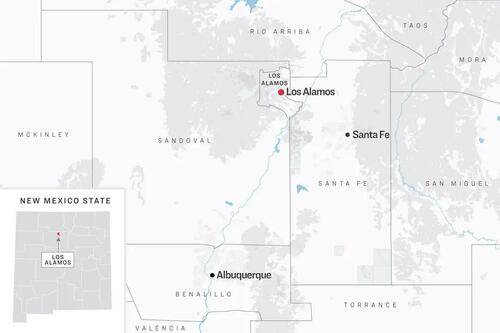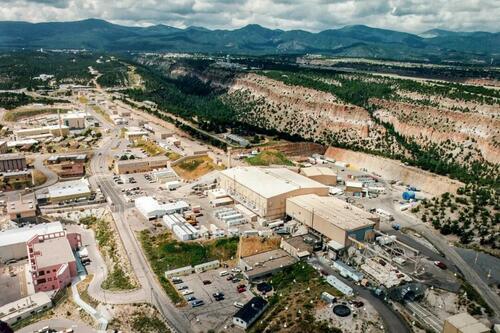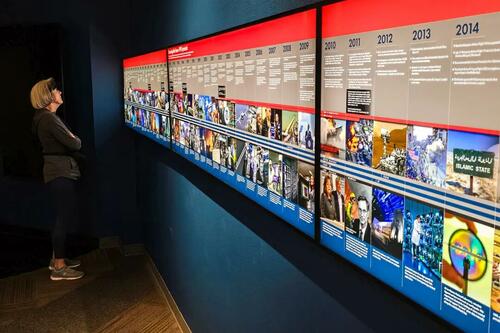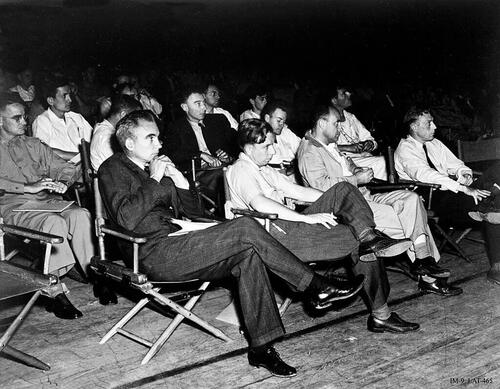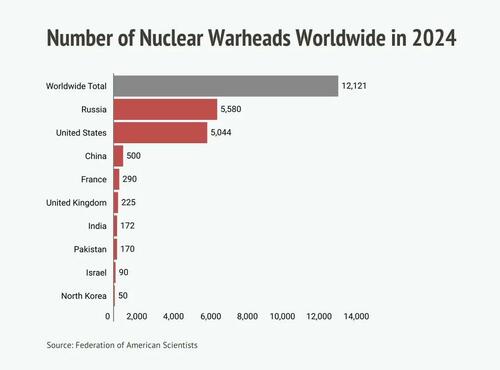New Mexico’s Nuclear Town Has Big Housing Problem
Authored by Allan Stein via The Epoch Times (emphasis ours),
Weekends bring a brief respite and slower pace to the Los Alamos townsite in New Mexico, the birthplace of the atomic bomb nearly 80 years ago.
Silent mountains thick with Ponderosa pine surround the town where some of the nation’s best-kept military secrets reside.
The urban sidewalks are empty, except for the occasional tourist or dog walker, and many of the shops, restaurants, and office buildings are closed.
There’s no traffic on the road from Trinity Drive to Oppenheimer Drive.
But, it’s just a matter of time before Los Alamos townsite jumps back into action.
“You will see it on Monday,” said one resident, who lives in White Rock, 10 miles from the greenscaped Los Alamos urban center.
Sure enough, on Monday morning, Los Alamos townsite roars back to life as commuters arrive by the thousands. The population nearly doubles in this “census-designated place” of 13,460.
Cars line up at security checkpoints to enter the Los Alamos National Laboratory (LANL), the county’s biggest employer and the reason for the sudden increase in population.
Employees clear the first barriers, then move through more checkpoints to get to their jobs four days a week.
Many drove from residential areas across Los Alamos County (population 19,187) and as far away as Albuquerque, 96 miles south, and the state capital of Sante Fe, about 35 miles north.
There has always been a housing shortage in the county, local officials say, but the pressures are growing as LANL reaches peak employment at around 19,000. The lab hopes to begin offering round-the-clock shifts in 2025.
The Los Alamos Affordable Housing Plan approved in August said the “acute” housing shortage hurts the local economy and limits housing to those who can afford it.
The study also found that in 2021, nearly 55 percent of the LANL workforce lived outside the county.
“Over 9,300 people commuted in for work, and only 21.8 percent, or 2,200 people, commuted out of the county while living here,” the study said.
‘One Horse Town’
“We’re a one horse town. Everything the lab does affects everybody,” said local realtor Chris Ortega, owner/broker of ReMax Los Alamos.
“The hiring has increased demand. There are fewer houses on the market than there were five or six years ago,” Ortega told The Epoch Times.
“People are coming and going all the time. Half of the lab lives here in Los Alamos. The other half lives off the hill somewhere—Santa Fe, Espanola, Albuquerque.”
In 2022, there were 8,149 households, 5,229 with families, in Los Alamos County. They were usually made up of two or three people per household and had an average income of $135,801.
“Based on employment rates and high wages, a family household making more than median income is likely to have a member of the family employed at Los Alamos National Laboratory,” according to the study.
A plurality of LANL employees agreed in a previous study that it would be beneficial to live in Los Alamos, provided they can find suitable housing near the lab.
Housing is hard to find and has been for a long time. Now, it’s worse because of LANL’s latest hiring surge that started around 2022 with the government’s plan to modernize the U.S. nuclear arsenal.
“It’s difficult [to find housing]. We hear it anecdotally from people we’re hiring—people from the lab,” said Linda Matteson, assistant county manager for Los Alamos County.
Only 14 percent of the land around Los Alamos is county-owned or privately owned, she said. The U.S. Forest Service, Park Service, and U.S. Department of Energy (DOE) own the rest.
“We’re very constrained,” Matteson told The Epoch Times. “Of that 14 percent, think about private houses, private land. Think of our geography with mesas and canyons. It’s limited. We, the county, own less than 10 parcels that we could develop. Some are open spaces that you wouldn’t want to develop.”
The plan found that because there isn’t enough housing, many people who do essential work in the community can’t live in the community.
The median sold price of homes in Los Alamos was $599,583 in September, representing a 6.3 percent increase from last year, according to a Rocket Homes report. In the same month, there were 61 homes listed for sale.
According to the housing plan, rental costs have more than tripled. Real estate website Zillow lists 33 current rentals available and a 3 bed, 1 bath house is listed for about $3,000 per month.
The lab employed 11,743 workers in 2018 and 15,707 workers in 2022, and it is hiring hundreds more this year and next before slowing down.
Meanwhile, in the same four-year timeframe, the county population only grew by 400 people because of housing constraints.
“This reflects the high percentage of commuters into the county, a limited supply of available housing, and the potential displacement of families with less financial resources by those with more,” the plan noted.
The plan projects that the county will require 1,300 new homes between 2024 and 2029 to preserve the status quo, and 2,400 new homes to meet future housing demand.
Tax Revenue
The fiscal year 2022 budget for LANL included nearly $2 billion in salaries for employees and $155 million in tax revenues for the county.
The lab was responsible for creating 24,169 jobs and contributing $3.12 billion to businesses in New Mexico.
Matteson said that LANL accounts for about 85 percent of the Los Alamos County’s gross property tax revenues.
“People come here because of the quality of life and amenities and things like that. The county feels it’s our job is to maintain those, increase where we can, and provide those services so people still want to live here,” Matteson said.
In September 2022, LANL announced its master development plan for the next 30 years.
The plan includes an upgraded facility powered by 100 percent renewable energy from solar and wind. The goal is to have zero carbon emissions by 2040.
Atomic Legacy
LANL has come a long way since the top-secret Manhattan Project at Los Alamos that made the first atomic bombs used at the end of World War II.
On Aug. 6, 1945, the United States dropped a uranium bomb called “Little Boy” on Hiroshima, Japan. Around 140,000 people died in the explosion, which had the force of 15 kilotons of TNT.
On Aug. 9, 1945, the second 21-kiloton atomic bomb, dubbed “Fat Man,” was dropped on Nagasaki, Japan. It killed 74,000 people.
Los Alamos National Laboratory, built in 1943, played a leading role in the development and production of the U.S. nuclear arsenal during the Cold War.
The $39 billion facility is located about 35 miles from Santa Fe. It covers nearly 40 square miles of DOE property, nearly 900 buildings, and 13 nuclear facilities.
From 1952 to 1989, plutonium production for U.S. nuclear weapons took place at the Rocky Flats plant near Denver.
When Rocky Flats closed, PF-4 at Los Alamos became the only plutonium facility in the country. The National Nuclear Safety Administration (NNSA) monitors and oversees the recycling of plutonium from old pits to make new ones by LANL.
“Today, the Laboratory is laying the groundwork for manufacturing new pits that are bound for a weapon already in the stockpile, the W87-1 nuclear warhead,” according to LANL.
“Los Alamos National Laboratory remains the only place in the country where pits can be made. This critical mission endures as the driving force for national security through deterrence.”
LANL declined a tour request by The Epoch Times.
Building a Better Bomb
The 2022 Nuclear Posture Review of the U.S. Department of Defense identified improving America’s nuclear deterrent as a top priority in the face of emerging global threats and challenges.
“That modernization effort, which is being carried out over the next two decades, includes initiatives to modernize all three legs of the nuclear triad,” according to a Defense Department statement.
The new intercontinental ballistic missile (ICBM) system, Sentinel, will replace the old Minuteman III, which entered service in 1970 and will continue to operate until the mid-2030s.
The Columbia class ICBM submarine will replace the Ohio class submarines, and the B-21 Raider will replace the B-2A Spirit bomber.
The program also calls for upgrading nuclear warheads at LANL, which the DOE controls. The research and production capabilities of the lab are central to that modernization effort.
A law passed in 2018 authorized the lab’s plutonium production facility to make 30 plutonium warhead cores, or “pits,” each year by 2026. They will be used to replace the cores in the aging nuclear stockpile.
The nuclear weapons to receive the plutonium pits made at LANL include the W87-1 warhead for the next-generation Sentinel ICBM, the submarine-fired W93 bomb, and the W76, W78, and W88 warheads.
As reported by the Federation of American Scientists, there are 12,121 known nuclear warheads in the world in 2024.
There were 5,580 in the Russian Federation, 5,044 in the United States, 500 in China, 290 in France, 225 in the United Kingdom, 172 in India, 170 in Pakistan, 90 in Israel, and 50 in North Korea.
Read the rest here…
Tyler Durden
Sun, 10/06/2024 – 23:20
via ZeroHedge News https://ift.tt/TSwXjtY Tyler Durden


